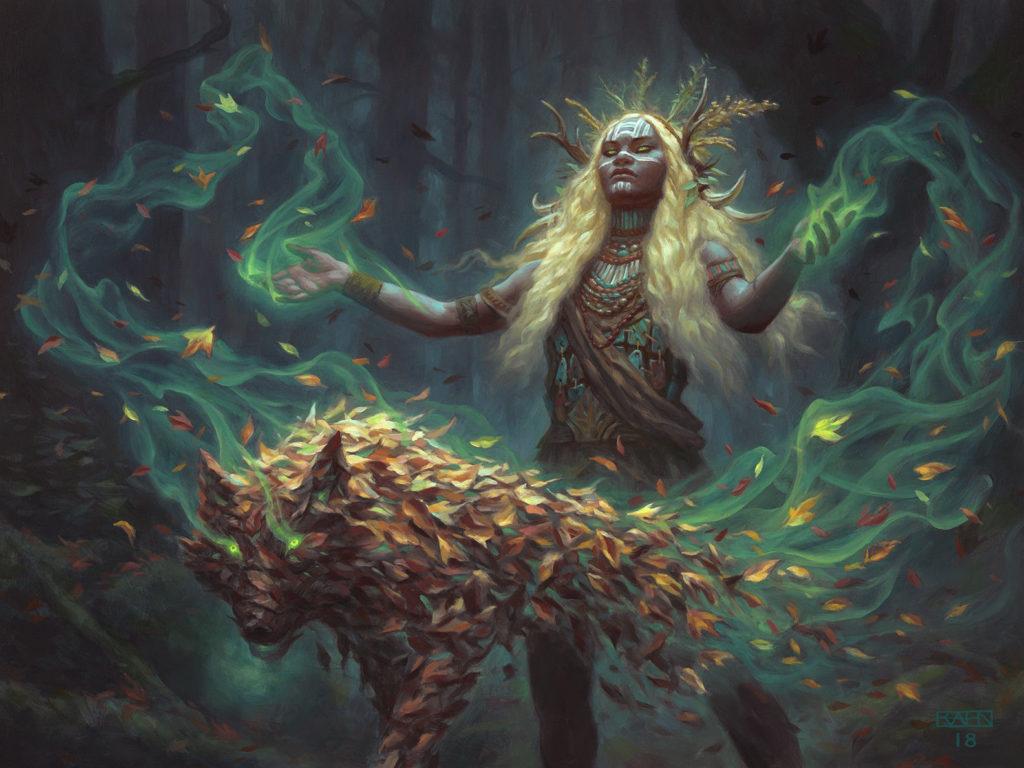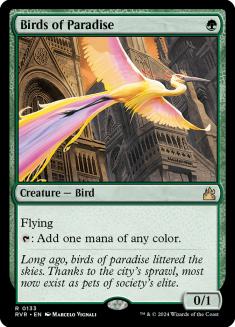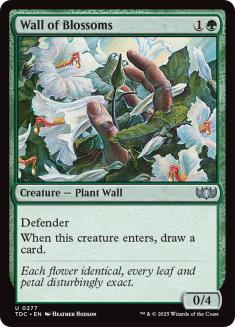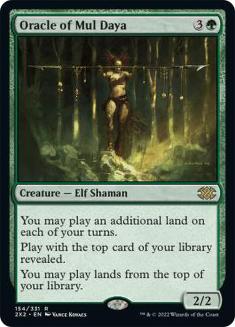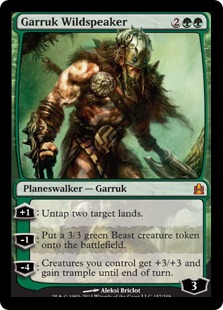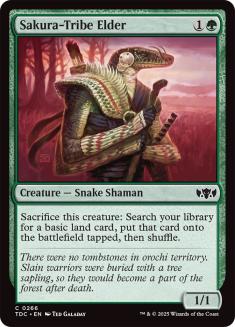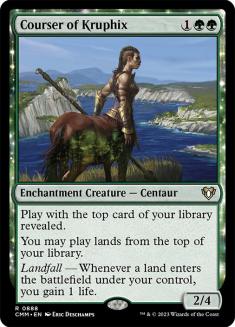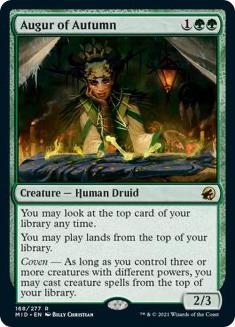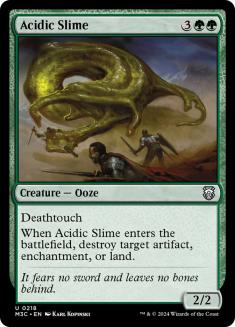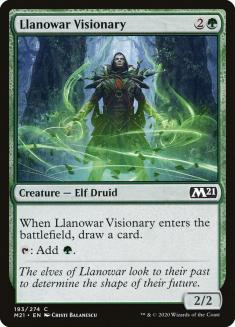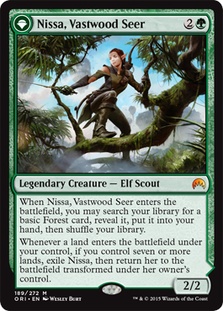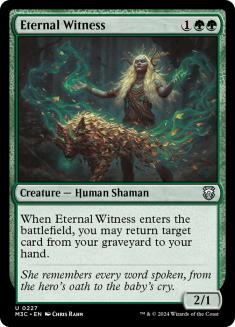Another week, another entry in my list of the most Cubeable cards in Magic! Last week I tackled red, which means this week I’ll be going over the final mono-color entry in the series with green.
The Challenge of Green
Green can be a very frustrating color to try to balance in Cube. This is because green is very good at accelerating mana and has a lot of shortcomings with regard to most of the other things the color does. This would be fine if pumping every Cube with a bunch of mana acceleration led to good gameplay, but frankly, it doesn’t.
You’ll fairly commonly see me identify green as being the best or second-best color in many of the digital Cubes, and that’s because fast mana can really take over games. Vintage Cube is more or less the fast mana format, and it’s easy to understand how one player having access to six mana to the other player’s four can lead to all kinds of snowballing advantages. This is less true in lower powered formats where the win conditions just take longer to close games and trade with cheaper cards more readily, but it’s always something that you’ll want to pay mind to.
My list today does have a fair amount of mana acceleration on it, so again, it’s not a bad thing to include categorically; there are just better and worse ways to do it. I’ll touch on this in the individual entries, but investing more mana than what you get and giving the opponent some opportunity to interact are the criteria that lead to the most engaging gameplay for both players. You’ll soon see what I mean, because it’s time to get to the list!
10. Birds of Paradise (and Assorted One-Mana Creatures)
I’ve generally given the nod to commons over rares for similar effects, but I’m enough bigger on Birds of Paradise than Llanowar Elves that I went with the rare here. Making mana-fixing as a strength as opposed to just mana acceleration relieves green being bad at other things, and Llanowar Elves has some aesthetic baggage, at least from my perspective. If you see a Llanowar Elves, does it mean that Fyndhorn Elves and Elvish Mystic are also present? This is akin to my hang-up with assorted Searing Spears, so I don’t expect everyone to see the issue I perceive.
Including many mana creatures does lead to the opposite problem that a bunch of Lightning Strikes does, though. You start to see green decks run away with more games if the other colors don’t have sufficient access to mana acceleration. I like a spread of Birds of Paradise, Noble Hierarch, and Ignoble Hierarch for my mid-powered Cubes and would caution against going much heavier than that. Ultimately, the most desirable play pattern of Birds of Paradise is the opponent immediately tagging it with a Lightning Bolt, but giving green players the dream of untapping with one and letting them do so on occasion is fine.
It turns out that I have more negative things to say about Birds of Paradise than positive ones! Fully excluding these sorts of effects can leave green completely anemic and uninteresting to draft, though. I might like the idea of Pelt Collector showing up in the one-slot more, but the power just isn’t there for most Cubes. The best way to go about it for most Cubes is to give green some of its iconic mana accelerants, but to make sure that the other colors have some tools to push back against them.
9. Wall of Blossoms
Wall of Blossoms fits much better in green than Wall of Omens does in white. If you think about the most powerful green decks as compared to Wall of Omens blocking for planeswalkers in medium white decks, you might not agree, but when you consider the range of things Wall of Blossoms offers to green, I find it to be significantly wider.
Both colors meaningfully lend support to blink decks, but green has effects in high- and low-power-level Cubes alike that care about having a high volume of creatures. Whether you’re playing with Gaea’s Cradle or Spider Spawning, Wall of Blossoms is a welcome addition to the team. Similarly, Wall of Blossoms is excellent in tandem with Natural Order or as part of a “Wall Tribal” strategy with cards like Overgrown Battlement. Wall of Omens mostly lives or dies on relative rate, whereas Wall of Blossoms more meaningfully contributes to more archetypes.
When you consider that green won’t often be much of a beatdown color, you see more of the value of Wall of Blossoms as well. It won’t always be the first green card that you take out of a pack, but a very high percentage of green decks will play Wall of Blossoms pretty happily. The card gets outclassed when you really push mana acceleration, but I’m plenty happy having Wall of Blossoms alongside a lot of messed-up Vintage Cube cards, so it has value everywhere.
8. Oracle of Mul Daya
Oracle of Mul Daya’s abilities are very powerful, but there’s some variance involved, and four mana is a lot to pay for a 2/2. That fragility is an important part of my endorsement of the card here. Oracle of Mul Daya does a great job of keeping spells flowing for its controller as it clears lands off the top of their deck, but it’s quite easy for most opponents to answer. Something about the blend of aspiring to completely take over a game with Oracle of Mul Daya alongside Jace the Mind Sculptor and the card dying to Shock is incredibly charming.
It’s pretty typical for green in most Cubes to feature more expensive spells than the other colors, which means you’ll want some stuff to do on four mana and some ability to keep attempting to ramp your mana at that point on the curve. Other four-mana spells like Questing Beast just aren’t nearly as appealing in most green columns. Oracle plays much better to green’s strengths and is on-plan for more green decks.
7. Tireless Tracker
I can conceive of criteria that put Tireless Tracker as somebody’s top green card. What is a green deck doing that it doesn’t want to play Tireless Tracker? Playing Oath of Druids I guess, but in general Tireless Tracker is just a great card for almost any green deck. Green has plenty of ways to accelerate mana and make extra land drops, so the modest value that Tireless Tracker seems to promise on its face ends up being very powerful in practice. All while dying to Shock the turn the card is cast!
Combining Tireless Tracker with fetchlands is a big part of the draw in higher-powered Cubes, but I found that the card can still hang even without fetchlands present in my original Twobert. I don’t really have a bad thing to say about Tireless Tracker, but you obviously can’t include it in rarity or set-restricted Cubes, and I could see it being problematic if you’re into very low-power environments.
6. Garruk Wildspeaker
Garruk Wildspeaker is my pick for the best-designed planeswalker of all time. When you consider that Garruk was from the original cycle of planeswalkers in Lorwyn, this is pretty incredible. Garruk protects itself in a very green way by making blockers, can apply pressure with those 3/3s, and offers solid mana acceleration. The ultimate will often be game-winning, but isn’t heavy-handed. With all of this going on, the loyalty numbers just feel right, and attacking down a Garruk isn’t all that tall an order. Garruk Wildspeaker is the perfect combination of swingy, balanced, and fun.
Another awesome aspect of Garruk is that it’s not always obvious which ability you should be using. Using the plus to cast a big spell can leave you vulnerable to interaction from the opponent into them attacking your Garruk down. Using the minus leaves Garruk’s loyalty very low. The puzzle isn’t so complex as to be a turn-off, but there’s enough going on that the decision of which of Garruk’s abilities to use takes some thought every turn. I don’t know how many people appreciate Garruk Wildspeaker as much as I do, but I’m not about to change.
5. Sakura-Tribe Elder
Sakura-Tribe Elder isn’t a form of mana acceleration that you can generally interact with, but paying two mana to accelerate your mana by one is a fair enough rate. You can go overboard with this sort of thing on volume (I’m looking at you, Signets!) and Farseek was once a format-defining card in Standard, but I don’t find that Sakura-Tribe Elder is all that difficult to balance around in Cube.
The reason that I go for Sakura-Tribe Elder as my Rampant Growth effect of choice is that the card meaningfully contributes to more archetypes while otherwise being functionally very similar. Sakura-Tribe Elder can soak up an attack before being sacrificed, contributes to the archetypes that care about having a high volume of creatures, is an easy creature for delirium, and can wield a Sword of Fire and Ice when push comes to shove. It’s a lot more than just a ramp spell, and that versatility is why I often include Sakura-Tribe Elder in my Cubes, while I rarely reach for Rampant Growth.
The line for a lot of Cubes isn’t far above Sakura-Tribe Elder, though. Cards like Devoted Druid and Rofellos, Llanowar Emissary offer enough extra mana that they can completely take over a game on Turn 3, so despite allowing interaction, they can be more problematic. I also find Sylvan Caryatid to be inappropriate for a lot of Cubes, with the 0/3 hexproof body being obnoxious against many aggressive decks. Sakura-Tribe Elder very much exists in the sweet spot.
4. Courser of Kruphix (and Augur of Autumn)
I lump these cards together because they are incredibly similar, but Augur of Autumn can more easily run away with a game. I like both cards quite a lot for Cube, but Courser of Kruphix is the headliner here because it’s much easier to believe that Augur of Autumn is too powerful for a particular Cube. There’s a little give and take with Courser having the fourth point of toughness, but the power ceilings simply aren’t comparable here.
Courser and Augur generate card advantage rather than accelerating mana; to the extent that they can run away with games, it will take more time to do so. They both offer solid stats while being somewhat vulnerable to removal, which makes one or both welcome additions to many Cubes.
There is a bit of a dance going on with Courser of Kruphix relative to red decks. I always like to give red access to Flame Slash and maybe another answer or two so as not to be completely bricked by Courser, but you can also eschew those and treat Courser as a way to push back against the power of Mono-Red Aggro. Augur of Autumn is much less of a factor for red decks, and there’s no right or wrong way to approach this balance, but I do think that it’s meaningful to think of Courser as an anti-red card and decide how much you care about that sort of thing. Signed, a concerned red player.
3. Acidic Slime
Green has a lot of awesome fives at this point in Magic’s history, but only one that scales all the way from Peasant Cube to Vintage Cube. Acidic Slime is a nice safety valve against troublesome enchantments and artifacts, made completely maindeckable by both deathtouch and the ability to destroy lands. Whether you’re casting Acidic Slime ahead of schedule or blinking it, it’s a surprisingly powerful card for a five-mana 2/2.
I honestly find that at least a little mana denial is a good thing to have around in Cube. No matter what you do, your Cube is going to deliver some unbalanced matchups. Aggressive decks with reach and some cards that can stifle the opponent’s development are two of the best ways to stop the decks with the most powerful end-games from winning every match. I’m not saying that you should include Strip Mine in your unpowered Cubes, but I am saying that I don’t have a lot of sympathy for players who are vulnerable to five-mana Stone Rains.
2. Llanowar Visionary (and Nissa, Vastwood Seer)
I’ve heard Llanowar Visionary described as the green Solemn Simulacrum, and in 2022 it’s reasonable to get that sort of value from a three-mana card. I find Nissa, Vastwood Seer to be generally comparable on power level, though there’s some give and take with regard to what the cards actually do, with Llanowar Visionary being a mana accelerant. The takeaway is that these cards are both very good and very reasonable for three mana. I’m also just a fan of Borderland Ranger, though it’s convincingly weaker than both of these cards and will be more of a card specifically for low-power Cubes.
Continuing to hit your land drops and develop your mana into the late-game is the most important thing for green decks to do in most Cube environments, and these cards offer a lot on that front, all while, you guessed it, dying to Shock. These cards are powerful without being overwhelming. They’re also not embarrassing, which I just can’t bring myself to say about Yavimaya Elder. These cards are very easy for me to slot into a lot of Cubes.
1. Eternal Witness
Regrowth is serviceable, but Eternal Witness is just good. No buts about it, this card has been a hit ever since its first printing in Fifth Dawn, which was far longer ago than I’d like to admit. Whether you’re rebuying a removal spell, a haymaker, or just a fetchland to hit your land drop, Eternal Witness is nice to have around. It’s another body for those creatures-matter strategies as well.
If you’re fine with someone playing a card in your Cube, you’re probably fine with them playing it twice. Eternal Witness is a modest rate, and it’s one that can hang everywhere from Peasant Cube to Vintage Cube. Eternal Witness is always one of the first cards that I add to my green columns, and I’ve never found it to be out of bounds on power level, despite nearly always making somebody’s deck.
And that does it for green, and by extension the mono-color portion of this series! Amusingly, green was the only color for which I didn’t choose a one-mana spell as my top card. It would’ve been easy and agreeable to many to just lock in Llanowar Elves, but as I’ve said, Llanowar Elves has plenty of baggage. I’d rather be honest than agreeable.
Next week I’ll be doing gold cards, which will take a slightly different form from the mono-color entries in this series. If you had to guess, you’d probably have determined that there will be one card for every two-color pair. Check back next week to see my picks!

